by Amineddoleh & Associates LLC | Aug 10, 2022 |

Museo dell’Arte Salvata (Copyright: Leila A. Amineddoleh)
Amineddoleh & Associates LLC is proud to work as a leading law firm in the cultural heritage sector. We have worked with collectors, dealers, museums, law enforcement agencies, and even foreign governments. One of our clients is the Republic of Italy, a nation paradoxically blessed with an abundance of artistic and cultural treasures, but cursed with the solemn responsibility of protecting those treasures. Properly monitoring antiquities and archaeological sites, regulating the market, and protecting cultural heritage is a costly and heavy burden. Every region of the Italian nation is famed worldwide for its cultural treasures, and so the country has developed means to actively protect its heritage through various channels. For instance, Italy is the first nation in the world to have a military unit responsible for the protection of art and heritage.
The Carabinieri Headquarters for the Protection of Cultural Heritage (Comando Carabinieri Tutela Patrimonio Culturale, or TPC) was instituted in 1969. The TPC is a part of the Ministry of Culture and plays an important role regarding the safety and protection of the heritage. The TPC is renowned for its efforts and works with law enforcement agencies around the world to recover stolen and illicitly exported artifacts, assists in heritage protection and management globally, recovers stolen art within Italy and abroad, and works to monitor and regulate the art market for looted or illicitly removed art and antiquities.
The TPC has had tremendous success over the decades, recovering hundreds of thousands of objects worth billions of dollars. In a thrilling recent escapade during 2020, the TPC tracked down a 500-year-old painting stolen from a museum in Naples. Jesus Christ in his “Savior of the World” (Salvator Mundi) aspect. The work is a copy of the infamous Salvator Mundi that sold for over $450 million in 2017 (considered the world’s highest-selling painting to date). The police found this copy stashed in the cupboard of an apartment and arrested the 36-year-old property owner. It was probably easy to spot among the inhabitant’s mismatched cutlery.

Castel Sant’Angelo (Copyright: Leila A. Amineddoleh)
The elite and highly specialized force has celebrated its successes in countless repatriation ceremonies and with art exhibitions. In particular, 2009 marked one of the most high-profile returns resulting from TPC investigations. The Metropolitan Museum of Art (the “Met”) returned the Euphronios Krater (infamously known as the “Hot Pot”) to Italy once the TPC and Swiss authorities uncovered an extensive looting network selling black market antiquities from Italy. These objects wound up in the hands of reputable collectors and museums, including the Met, the Museum of Fine Arts in Boston, the Getty Museum, Harvard University, and the Cleveland Museum of Art. In the wake of this return, hundreds of other items from that network were returned. These restituted works were exhibited in the Colosseum with much pomp, circumstance, and celebration.
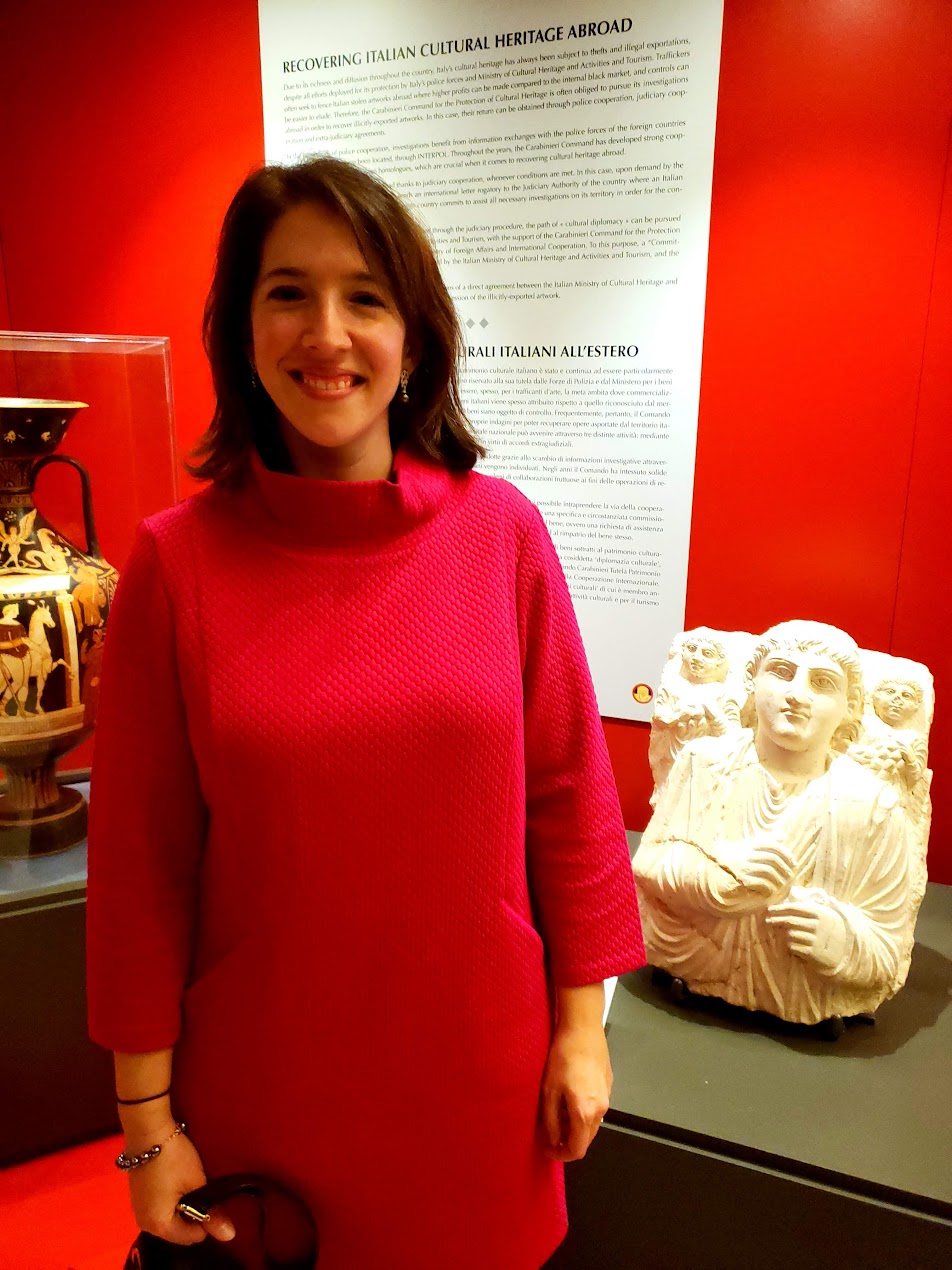
At the United Nations in January 2020
A decade later, in 2019, in honor of the TPC’s 50 anniversary, the Carabinieri, the Italian Ministry of Foreign Affairs and International Cooperation, and the Italian Ministry of Cultural Heritage and Activities organized a comprehensive exhibition of recovered art. “Recovered Treasures: the Art of Saving Art” was on view in Paris and then displayed at the United Nations in New York in January 2020. Our founder, Leila Amineddoleh, was invited to attend this exclusive event to open this once-in-a-lifetime exhibition. At the opening, Secretary-General of the United Nations Antonio Guterres aptly stated that the “exhibition not only comprises priceless works of art, it also paints a picture of the power of international cooperation.”
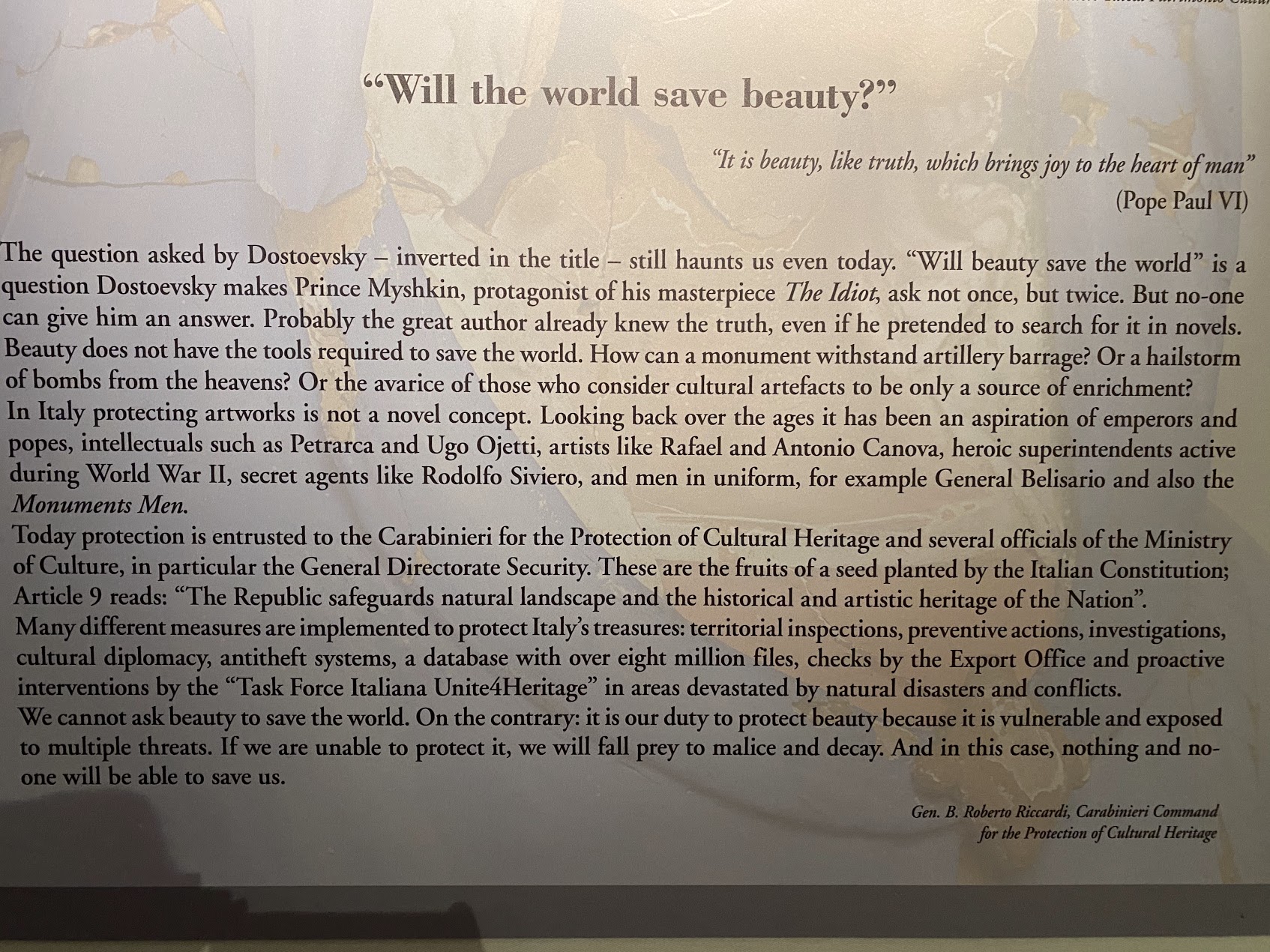
Sign at the entry of “Will the world save beauty?” exhibition
When Italian museums finally reopened after the Covid pandemic, the Castel Sant’Angelo in Rome hosted an exhibition entitled “Will the World Save Beauty?,” a show dedicated to exhibited repatriated antiquities, items recovered after natural disasters, works stolen from churches and private institutions, the prevalence of forgeries, and even stolen instruments. Leila also received an invitation from the Carabinieri to view this jaw-dropping show. The juxtaposition of recovered antiquities in a building with nearly 2,000 years of history was both ethereal and moving. This historic site had survived sacking and plundering, and so it was particularly effective to experience repatriated artwork in such a historically rich setting.

Copyright: Leila A. Amineddoleh
At the start of this summer, Minister of Culture Dario Franceschini announced the opening of the Museo dell’Arte Salvata (“Museum for Rescued Art”), a new museum displaying looted works returned to the Mediterranean nation. The concept for this museum is innovative and appealing – hundreds of smuggled, and now repatriated, artworks will be displayed for public view. But the particular items on display will rotate, with the next group of pieces to be presented after October 15, 2022. Once the displayed works are removed, they will be returned to the respective regions of Italy from where they were originally stolen. The museum’s noble aim is to return objects to the collections of small museums that have suffered from the loss of artwork, giving them and the nation of Italy as a whole a boost to aid in post-pandemic recovery for the culture sector.
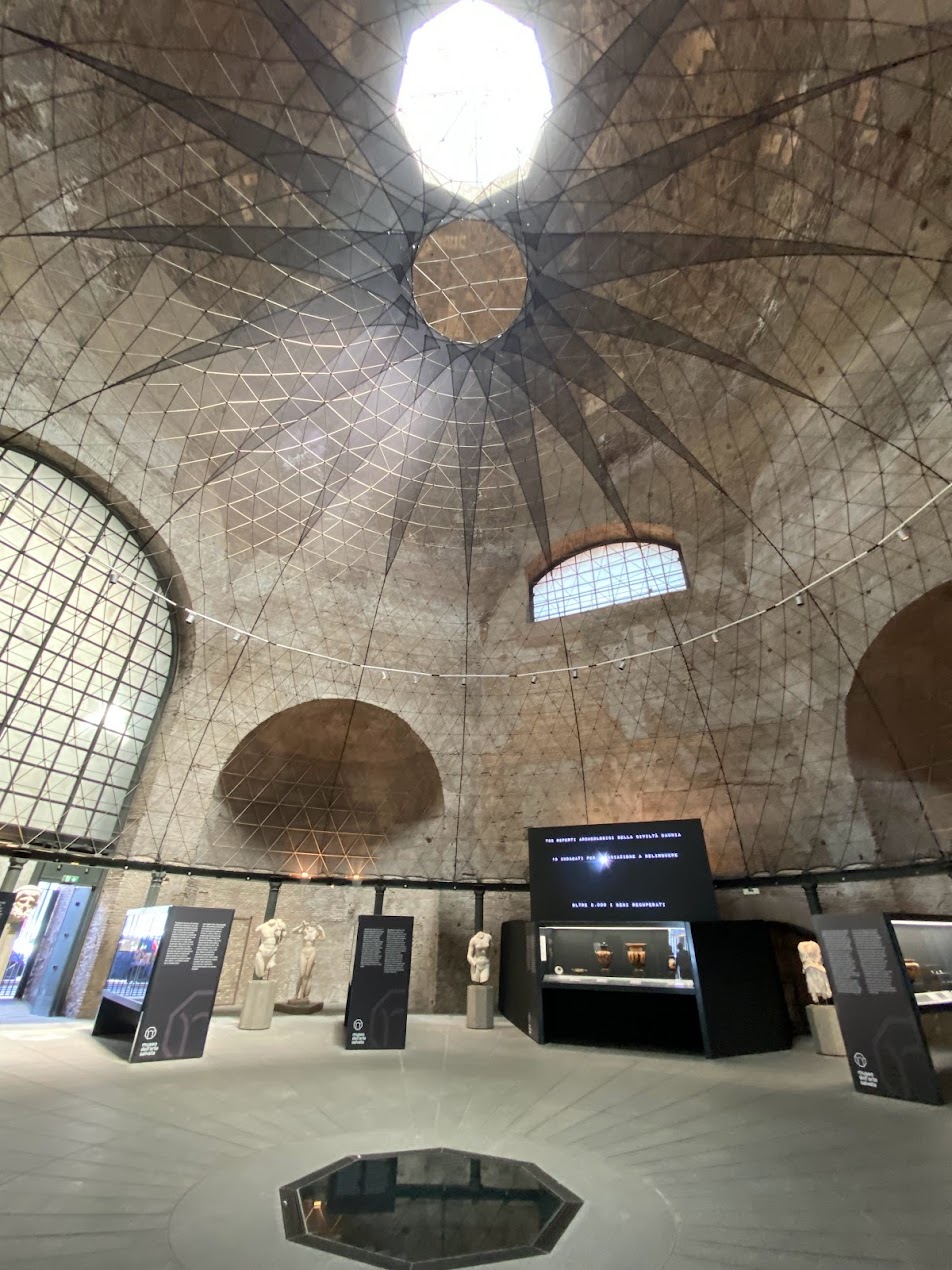
Copyright: Leila A. Amineddoleh
Our founder had the pleasure of visiting the museum shortly after its fabulous opening. The museum is intimate (the objects are all displayed in one large room), and the exhibition is excellent. The repatriated objects on display are organized in glass vitrines featuring information about the works’ significance, the ways in which they were smuggled, and the importance of repatriation. The museum notes that the objects on display are “mainly from the United States of America.” The United States (in particular, New York) is the center of the art market and so items are sold both legally on the market and illicitly. But US authorities have also been instrumental in recovering stolen and illicitly exported objects linked to Italy.
Franceschini stated: “Stolen works of art and archaeological relics that are dispersed, sold or exported illegally is a significant loss for the cultural heritage of the country…. Protecting and promoting these treasures is an institutional duty, but also a moral commitment: it is necessary to take on this responsibility for future generations.” Stéphane Verger, director of the National Roman Museum, poignantly noted: “I think of this as a museum of wounded art, because the works exhibited here have been deprived of their contexts of discovery and belonging.”
Just a month after this exhibition’s opening, another 142 Italian antiquities seized by the Manhattan DA are headed home to Italy. This included 48 items recovered from private collector Michael Steinhardt during a high-profile seizure in December 2021, where the former hedge fund manager agreed to surrender $70 million worth of antiquities. The most valuable work returned to Italy is a fresco depicting an infant Hercules strangling a snake, valued at $1 million and looted from Herculaneum. Officials revealed that another 60 of the items were recovered from Royal-Athena Galleries in Manhattan.
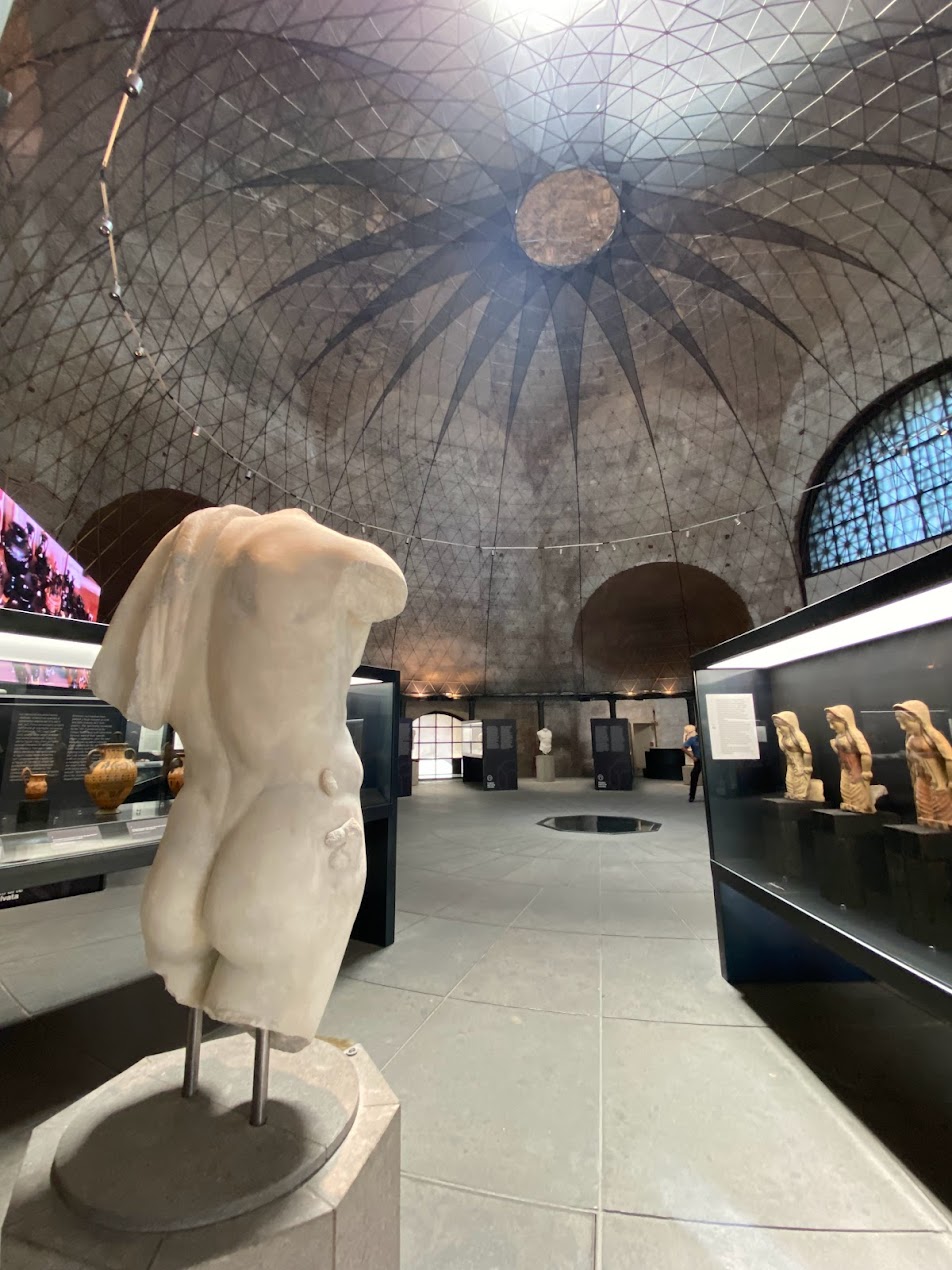
Copyright: Leila A. Amineddoleh
As this law firm is currently representing the Republic of Italy in an ongoing antiquities dispute, and our founder served as a cultural heritage law expert for the Manhattan District Attorney’s Office regarding the seizure of items from Michael Steinhardt, traveling to Rome and visiting such an impressive and important exhibition was – in Ms. Amineddoleh’s word – both powerful and gratifying. This highlights the impact of cultural heritage looting and trafficking at the global level and close to home.
The Museo dell’Arte Salvata is located in the Aula Ottagona, a building that had previously been closed for a number of years. The structure is part of the Baths of Diocletian complex, located a few minutes away from Termini Train Station (Rome’s main railway station), and across the street from the Repubblica subway station, in the heart of the Eternal City. Since it is part of the network of national Roman museums, visitors can purchase one ticket and see all five museums for one relatively inexpensive entry price. It is well worth the trip – and visitors can wrap up their visit with a large bowl of cacio e pepe and a hearty glass of Chianti Classico for a true Italian experience.
by Amineddoleh & Associates LLC | Aug 6, 2022 |
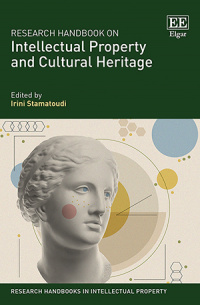 We are pleased to announce that “The Research Handbook on Intellectual Property and Cultural Heritage” was recently published by Edward Elgar Publishing. Our founder authored the chapter, “Cultural Heritage, Galleries and Auction Houses.” As an internationally regarded expert on cultural heritage law, Leila was invited to contribute to important publication. Her chapter discusses the historical development of cultural heritage protection, major antiquities controversies, and ways in which these ownership disputes are resolved. The book’s editor, Irini Stamatoudi, is a lawyer at the Supreme Court in Athens (Greece) and a Law Professor at the University of Nicosia (Cyprus). She also served as the General Director of the Greek National Copyright Office, Ministry of Culture and Sports.
We are pleased to announce that “The Research Handbook on Intellectual Property and Cultural Heritage” was recently published by Edward Elgar Publishing. Our founder authored the chapter, “Cultural Heritage, Galleries and Auction Houses.” As an internationally regarded expert on cultural heritage law, Leila was invited to contribute to important publication. Her chapter discusses the historical development of cultural heritage protection, major antiquities controversies, and ways in which these ownership disputes are resolved. The book’s editor, Irini Stamatoudi, is a lawyer at the Supreme Court in Athens (Greece) and a Law Professor at the University of Nicosia (Cyprus). She also served as the General Director of the Greek National Copyright Office, Ministry of Culture and Sports.
The book is available for purchase here.
by Amineddoleh & Associates LLC | Jul 27, 2022 |
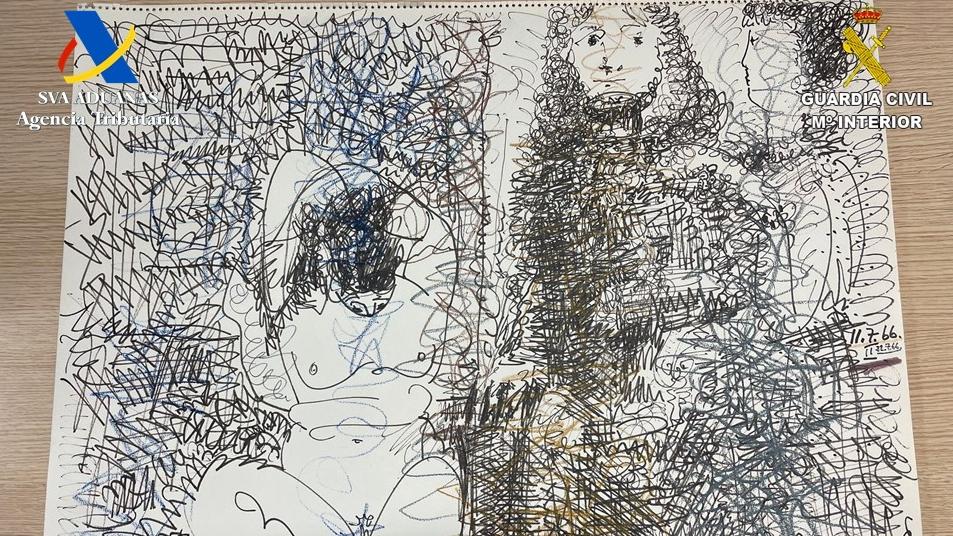 Last week, customs officials on the Spanish island of Ibiza discovered something a bit more exciting than the usual partygoers and tourists – a sketch by Pablo Picasso worth over $463,000. The sketch (Trois Personnages, 1966) was flown into Ibiza from Switzerland. It was found in a passenger’s suitcase after he failed to declare the contraband artwork. He attempted to pass off the original artwork as a print by presenting a falsified receipt listing its value as $1,550. Swiss customs officials noted that the work had been packed in a suspicious manner and alerted their Spanish counterparts. Once the plane arrived in Ibiza, customs officials approached the passenger. After being presented with the false receipt, the agents located another receipt at the bottom of the luggage revealing the supposed print’s true value. The sketch was quickly sent to an art expert, who confirmed its authenticity. The passenger now faces criminal charges of smuggling, failing to declare the value of the artwork, and presenting authorities with a false receipt. The sketch is in the custody of the Ibiza court overseeing the investigation.
Last week, customs officials on the Spanish island of Ibiza discovered something a bit more exciting than the usual partygoers and tourists – a sketch by Pablo Picasso worth over $463,000. The sketch (Trois Personnages, 1966) was flown into Ibiza from Switzerland. It was found in a passenger’s suitcase after he failed to declare the contraband artwork. He attempted to pass off the original artwork as a print by presenting a falsified receipt listing its value as $1,550. Swiss customs officials noted that the work had been packed in a suspicious manner and alerted their Spanish counterparts. Once the plane arrived in Ibiza, customs officials approached the passenger. After being presented with the false receipt, the agents located another receipt at the bottom of the luggage revealing the supposed print’s true value. The sketch was quickly sent to an art expert, who confirmed its authenticity. The passenger now faces criminal charges of smuggling, failing to declare the value of the artwork, and presenting authorities with a false receipt. The sketch is in the custody of the Ibiza court overseeing the investigation.
Yet this is not the first incident involving a smuggled Picasso in Spain. Jaime Botín, former chairman of Spanish bank Bankinter, was sentenced to 18 months in jail and received a $58 million fine (increased to $101 million) in 2020 after attempting to smuggle a painting by Picasso (Head of a Young Woman) out of the country aboard his private yacht. Botín had originally purchased the painting, worth $29 million, in London in 1977. He later planned to sell it at auction, but was unable to remove it from Spain. Christie’s London applied to the Spanish Ministry of Culture for an export permit in 2013 (on Botín’s behalf) but it was denied. The Ministry found that the artwork qualified as a national treasure since it was over 100 years old and the Ministry deemed it culturally significant. The painting is notable for being one of the few exemplars of Picasso’s Rose Period and presents various similarities with the figures in Les Demoiselles d’Avignon, one of the artist’s seminal works and a highlight of the Cubism movement. An art expert deemed the work unique and stated that it is highly unlikely that another painting with these characteristics exists in Spain – or Europe.
Botín was undeterred by the government’s pronouncement as he brazenly took it aboard his yacht, where he sailed to Corsica in 2015. French customs officials boarded the vessel and seized the painting at that time. It was suspected that Botín planned to take the work to Switzerland and sell it there. Botín claims that he was transferring the work abroad for safekeeping, and that he could do so as the legitimate owner of the painting. However, Spain’s patrimony law clearly prohibits the removal of national treasures from Spanish territory without the approval of the Ministry of Culture. The court’s imposition of a substantial fine is indicative of the seriousness with which Spain views attempts to circumvent its cultural heritage export ban; this is the first time a sentence of this magnitude has been imposed in a case involving artwork.
Head of a Young Woman is currently on view at the Reina Sofía Museum in Madrid, where it was transferred for safekeeping in 2015 after its seizure. It will feature in an upcoming exhibition to mark the 50th anniversary of Picasso’s death in 2023. Meanwhile, a court exempted Botín from serving his jail sentence due to illness and advanced age (85), although he ultimately paid the increased fine. He continues to maintain his innocence and stated that he hopes to display the painting at his family’s Centro Botín in Santander one day.
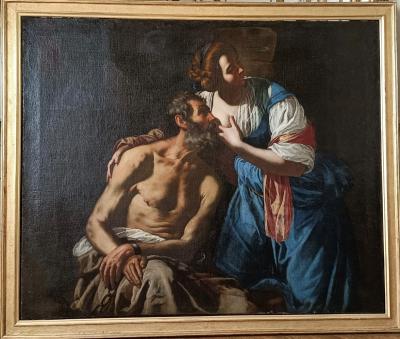 The problem with smuggled works is not unique to Spain. Just last week, it was reported that a 17th century painting by Artemisia Gentileschi was recovered after it was illegally exported from Italy. The work was recovered and repatriated from Austria to Bari. Two people are being investigated for fraud and illegal export of cultural goods. They disguised the attribution and concealed the historical importance of the work in order to obtain permission to export the painting out of Italy.
The problem with smuggled works is not unique to Spain. Just last week, it was reported that a 17th century painting by Artemisia Gentileschi was recovered after it was illegally exported from Italy. The work was recovered and repatriated from Austria to Bari. Two people are being investigated for fraud and illegal export of cultural goods. They disguised the attribution and concealed the historical importance of the work in order to obtain permission to export the painting out of Italy.
by Amineddoleh & Associates LLC | Jul 23, 2022 |
 Congratulations to our founder, Leila Amineddoleh, for being recognized by the Chambers and Partners High Net Worth Guide for Art and Cultural Property Law. The publication notes, “She is a brilliant attorney. She is smart, strategic, and forward-thinking. She is a go-to for cultural property matters.” Her colleagues also noted her passion for art and heritage and her knowledge on art law matters. Thank you for recognizing our firm as we continue providing high-level services for our clients.
Congratulations to our founder, Leila Amineddoleh, for being recognized by the Chambers and Partners High Net Worth Guide for Art and Cultural Property Law. The publication notes, “She is a brilliant attorney. She is smart, strategic, and forward-thinking. She is a go-to for cultural property matters.” Her colleagues also noted her passion for art and heritage and her knowledge on art law matters. Thank you for recognizing our firm as we continue providing high-level services for our clients.
by Amineddoleh & Associates LLC | May 31, 2022 |
Each May, the art world buzzes as art fairs hit New York City and the major auction houses host blockbuster international sales. After scaling back in 2020 and 2021 due to the Covid-19 pandemic, the art scene returned with gusto this spring. Even the Financial Times noted that New York’s 2022 auction season wrapped up “strongly,” after a series of record-breaking successes.

Shot Sage Blue Marilyn (courtesy of Christie’s)
Christie’s made headlines during its Spring Marquee Week when Andy Warhol’s “iconic portrait of Marilyn Monroe,” Shot Sage Blue Marilyn, sold to Larry Gagosian for a little over $195 million after just 4 minutes of bidding. This was the second-highest result for an artwork at auction, and the highest price ever paid for a work by an American artist. Notably, Gagosian had previously sold the work to Thomas Ammann in 1986, so the work is returning to its prior seller almost forty years later. (It is unclear whether Gagosian is keeping Marilyn for his own collection or whether he purchased it on behalf of a client.) Overall, the sale attracted bidders from 29 different countries and 68% of lots sold above their respective high estimates, demonstrating that collectors have not lost their appetite for contemporary art over the past two years. Works by six other artists, including Francesco Clemente and Ann Craven also sold for record prices while Cy Twombly and Robert Ryman occupied the top lots after Warhol. Christie’s Chairman of 20th and 21st Century Art, Alex Rotter, commented that this was a “historic night” and “a testament to the strength, the vibrancy, and the overall excitement of the art market today.”
Sotheby’s spring sales also broke records, with the second half of the Macklowe Collection up for grabs. Achieving a total of $922 Million, the Macklowe Collection won the distinction of becoming the most valuable collection ever sold at auction. The group of 65 works, including exemplars by Rothko, Warhol, Giacometti, and de Kooning, was sold during two separate auctions in the fall and spring (the first on November 15, 2021, and the second on May 16, 2022), driving up interest. The collection was formed by Harry B. Macklowe and his ex-wife Linda over the many decades of their marriage. In 2018, amidst acrimonious divorce proceedings and widely varying appraisals over the collection’s actual value, a New York State Supreme Court judge ordered the couple to sell the artworks and split the profits equally. Although the auctions were delayed due to Covid-19, it was well worth the wait.
 Finally, a third big auction house player made headlines for astronomical prices this spring. Phillips’ superstar was an untitled work by Jean-Michel Basquiat. The acrylic and spray paint on canvas from 1982 was estimated to sell for $70 million, but it surpassed expectations and brought in $85 million during an evening sale on May 18, 2022. The seller, Japanese mogul Yusaku Maezawa, had originally purchased the 16-foot-long work in 2016 for $57.3 million. Basquiat is currently enjoying a resurgence in popularity among both established and younger art collectors, with another work selling for $40 million last November.
Finally, a third big auction house player made headlines for astronomical prices this spring. Phillips’ superstar was an untitled work by Jean-Michel Basquiat. The acrylic and spray paint on canvas from 1982 was estimated to sell for $70 million, but it surpassed expectations and brought in $85 million during an evening sale on May 18, 2022. The seller, Japanese mogul Yusaku Maezawa, had originally purchased the 16-foot-long work in 2016 for $57.3 million. Basquiat is currently enjoying a resurgence in popularity among both established and younger art collectors, with another work selling for $40 million last November.
Artsy noted that the 20th-century and contemporary art auctions reflect a “shift in collector’s interests across the board with women artists, artists of color, and emerging artists receiving both critical interest and incredible financial interest.” The staggering results for some of these artists (often realizing much larger amounts their high estimates) may be the result of collectors seeking to purchase works by artists with potentially long and successful careers whose values may further increase. Several news sources noted that one of the stars in this field is Anna Weyant. The 27-year-old Canadian had her works sold at the three major auction houses (Sotheby’s, Christie’s, and Phillips) and high-profile galleries. Her work, “between sweet and sour, beautiful and foreboding” has surged in price and interest across the board.
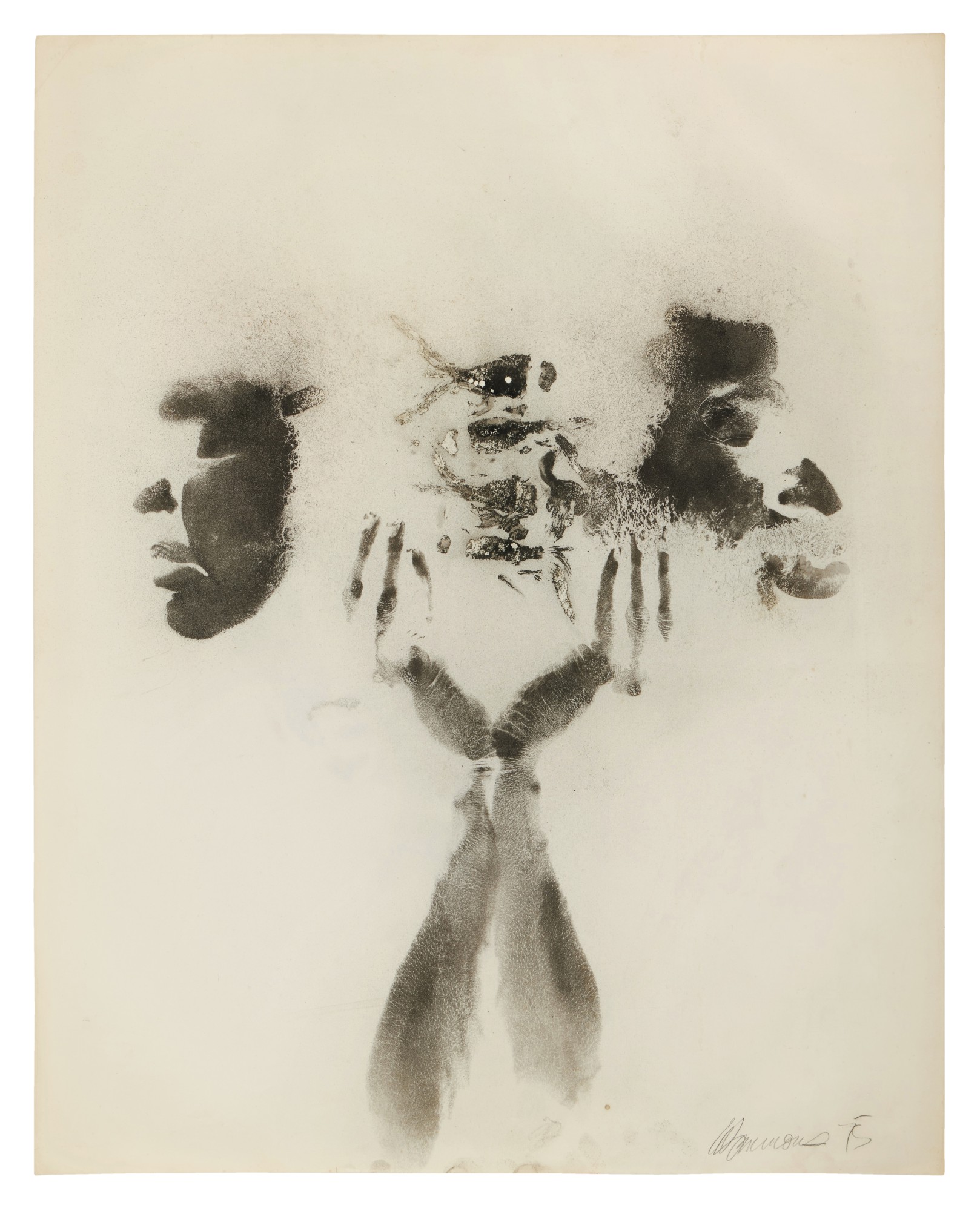 We were pleased to represent a number of collectors consigning important works at auction this spring. One of our clients is the collecting family that consigned three works by David Hammons for the Sotheby’s Contemporary Evening Auction on May 19. Sotheby’s touted these works and their provenance, after the paintings remaining with our clients for nearly five decades. All three of the works performed well, with two of them selling for above their high estimates. (The combined high estimate of the 3 works was $2.3 million, and they actually realized $2.6 million.)
We were pleased to represent a number of collectors consigning important works at auction this spring. One of our clients is the collecting family that consigned three works by David Hammons for the Sotheby’s Contemporary Evening Auction on May 19. Sotheby’s touted these works and their provenance, after the paintings remaining with our clients for nearly five decades. All three of the works performed well, with two of them selling for above their high estimates. (The combined high estimate of the 3 works was $2.3 million, and they actually realized $2.6 million.)
It is always gratifying to work with clients and help them achieve the best outcomes for the sale of artwork. We look forward to a continued season of strong art market sales and new and exciting artists as summer approaches.







 We are pleased to announce that “The Research Handbook on Intellectual Property and Cultural Heritage” was recently published by Edward Elgar Publishing. Our founder authored the chapter, “Cultural Heritage, Galleries and Auction Houses.” As an internationally regarded expert on cultural heritage law, Leila was invited to contribute to important publication. Her chapter discusses the historical development of cultural heritage protection, major antiquities controversies, and ways in which these ownership disputes are resolved. The book’s editor, Irini Stamatoudi, is a lawyer at the Supreme Court in Athens (Greece) and a Law Professor at the University of Nicosia (Cyprus). She also served as the General Director of the Greek National Copyright Office, Ministry of Culture and Sports.
We are pleased to announce that “The Research Handbook on Intellectual Property and Cultural Heritage” was recently published by Edward Elgar Publishing. Our founder authored the chapter, “Cultural Heritage, Galleries and Auction Houses.” As an internationally regarded expert on cultural heritage law, Leila was invited to contribute to important publication. Her chapter discusses the historical development of cultural heritage protection, major antiquities controversies, and ways in which these ownership disputes are resolved. The book’s editor, Irini Stamatoudi, is a lawyer at the Supreme Court in Athens (Greece) and a Law Professor at the University of Nicosia (Cyprus). She also served as the General Director of the Greek National Copyright Office, Ministry of Culture and Sports. Last week, customs officials on the Spanish island of Ibiza discovered something a bit more exciting than the usual partygoers and tourists – a
Last week, customs officials on the Spanish island of Ibiza discovered something a bit more exciting than the usual partygoers and tourists – a  The problem with smuggled works is not unique to Spain. Just last week, it was reported that a 17th century painting by
The problem with smuggled works is not unique to Spain. Just last week, it was reported that a 17th century painting by  Congratulations to our founder, Leila Amineddoleh, for being recognized by the Chambers and Partners High Net Worth Guide for Art and Cultural Property Law. The publication notes, “She is a brilliant attorney. She is smart, strategic, and forward-thinking. She is a go-to for cultural property matters.” Her colleagues also noted her passion for art and heritage and her knowledge on art law matters. Thank you for recognizing our firm as we continue providing high-level services for our clients.
Congratulations to our founder, Leila Amineddoleh, for being recognized by the Chambers and Partners High Net Worth Guide for Art and Cultural Property Law. The publication notes, “She is a brilliant attorney. She is smart, strategic, and forward-thinking. She is a go-to for cultural property matters.” Her colleagues also noted her passion for art and heritage and her knowledge on art law matters. Thank you for recognizing our firm as we continue providing high-level services for our clients.
 Finally, a third big auction house player made headlines for astronomical prices this spring. Phillips’ superstar was an untitled work by Jean-Michel Basquiat. The acrylic and spray paint on canvas from 1982 was estimated to sell for $70 million, but it surpassed expectations and brought in
Finally, a third big auction house player made headlines for astronomical prices this spring. Phillips’ superstar was an untitled work by Jean-Michel Basquiat. The acrylic and spray paint on canvas from 1982 was estimated to sell for $70 million, but it surpassed expectations and brought in  We were pleased to represent a number of collectors consigning important works at auction this spring. One of our clients is the collecting family that consigned three works by David Hammons for the Sotheby’s Contemporary Evening Auction on May 19. Sotheby’s
We were pleased to represent a number of collectors consigning important works at auction this spring. One of our clients is the collecting family that consigned three works by David Hammons for the Sotheby’s Contemporary Evening Auction on May 19. Sotheby’s